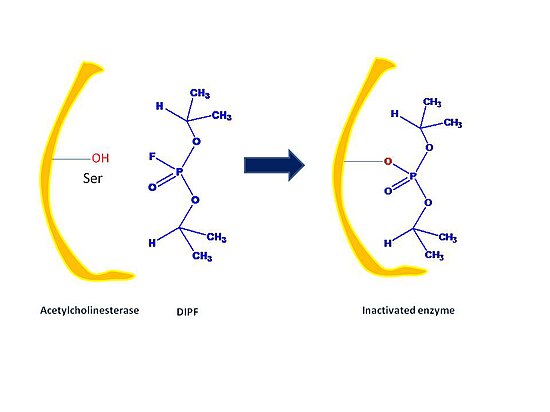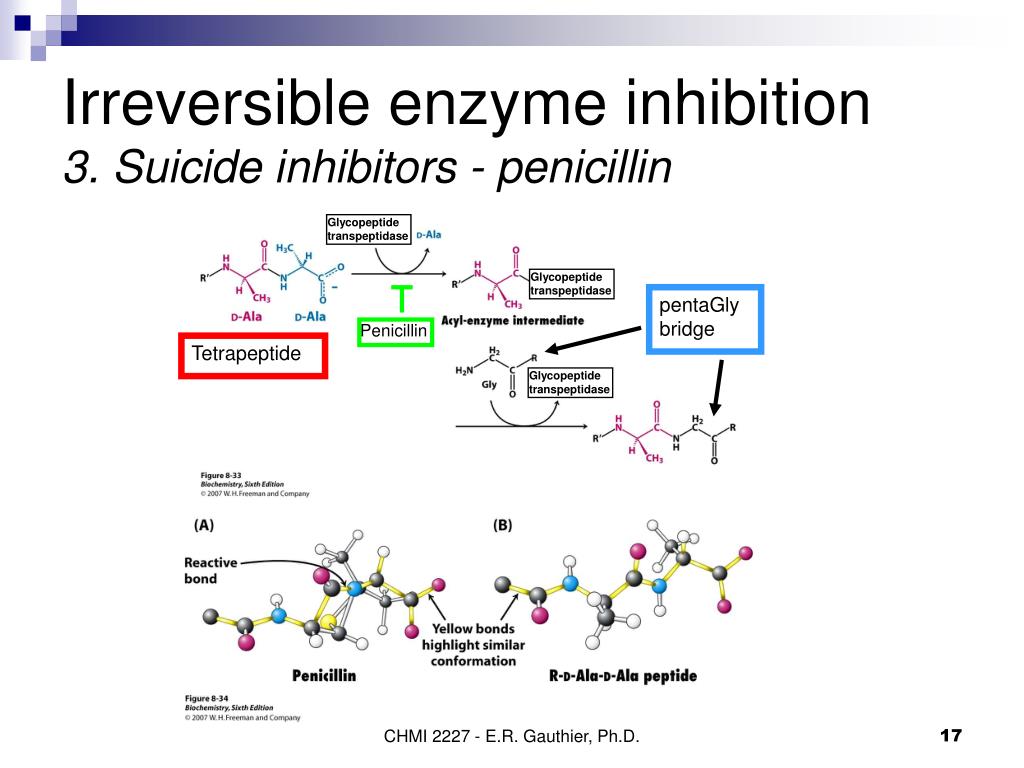Enzyme Inhibitors: Irreversible Inhibitors and Questions for GPAT, SSC, NEET
There are a large no of synthetic and naturally occurring compounds which have the ability to bind to a specific enzyme and alter their activity. These are known as enzyme inhibitors. Examples include: drugs, antibiotics, toxins, anti-metabolites and some natural products to enzyme reactions. Such inhibitors are divided in two classes according to their binding ability:
- Reversible inhibitors
- Irreversible inhibitors.
In this article we will study about irreversible inhibitors.
Irreversible inhibitors
An irreversible inhibitor binds with the enzyme tightly and forms a stable complex. It forms complex through covalent bond. The covalent bond dissociates very slowly that the inhibition is almost irreversible. An irreversible inhibitor cannot be released by dilution, dialysis or by increasing the concentration of substrate. Irreversible inhibitors are divided in 3 groups:
- Group specific inhibitors
- Reactive substrate analogs
- Suicide inhibitors
In enzyme kinetics, the effect of irreversible inhibitors is same as reversible non-competitive inhibitor, resulting in decreased Vmax , but no effect on Km.
Group specific irreversible inhibitor
These inhibitors binds to a specific-group of the amino acid in the enzyme that plays important role in enzymatic reactions, substrate binding.
Examples are:-
- Di-isopropyl-phospho-fluoride (DIPF)
- Iodoacetamide
- Heavy metals like platinum, silver mercury etc.
Group specific type of inhibitors are used to find out the participating catalytic active groups such as:
- Thiol group of cysteine
- Hydroxyl group of serine
- Imidazole group of histidine

Reactive substrate analogs or affinity labels
These are the molecules that are structurally similar to the substrates. These substrates posses highly reactive group which is generally not present in substrate. The reactive group of the inhibitor covalently reacts with enzyme and blocks the active site permanently.
Examples are:
- Tosyl-L-phenylalanine chloro-methyl ketone (TPCK)
- 3-bromoacetol phosphate (BAP)
Suicide inhibitor or Mechanism-based inactivation
- These inhibitors are the modified substances which modifies the enzyme’s active site. The inhibitor(initially un-reactive) binds to the enzyme as a substrate and carries out the first few catalytic activity of the normal enzyme reaction.
- Instead of forming a normal product, the catalytic activity generates a chemically reactive intermediate that inactivates the enzyme through co-valent modification. This makes the enzyme participate in its own irreversible inhibition. These inhibitors are known as Mechanism-based in-activators because they utilize the normal enzyme reaction mechanism to inactivate the enzyme.
Examples include:
- Penicillin
- Aspirin
- Disulfiram
- Deprenyl

Multiple Choice Questions (MCQs)
1. What type of compounds are enzyme inhibitors?
A. Naturally occurring
B. Synthetic occurring
C. Both
D. None
2. Inhibitors are classified in how many types?
A. 2
b. 3
c. 4
d. 5
3. How many types of irreversible enzyme inhibitors are present?
A. 2
B. 3
C. 4
D. 5
4. Match the following enzyme which is inhibited by the inhibitor –
a. DIPF 1. Glycopeptidyltranspeptidase
b. Aspirin 2. Chymotrypsin
c. TPCK 3. Cyclo-oxygenase
d. Penicillin 4. Acetylcholine esterase
5. In which type of inhibition, the inhibitor is structurally similar to substrate?
A, Group specific
B. Reactive substrate analogs
C. Suicide inhibitors
D. Mechanism based inhibitors
6. For which enzyme, penicillin acts as inhibitor?
A. Glycopeptidyltranspeptidase
B. Cyclo-oxygenase
C. Aldehyde dehydrogenase
D. Both A and C
7. The irreversible enzymes forms complex with enzymes through which type of bond?
A. Glycosidic bond
B. Covalent bond
C. Peptide bond
D. None of the above
8. which of the following statement is NOT true?
A. Lead is the example of reactive substrate analog
B. BAP is the example of reactive substrate analog
C. Group specific inhibitors reacts with amino group of enzyme
D. The effect of irreversible enzyme is similar to reversible competitive inhibitors.
9. Which of the following is an example of group specific irreversible inhibitor?
A. Heavy metals
B. Di-isopropyl-phospho-fluoride
C. Iodoacetamide
D. All of the above
10. Which type of inhibitor modifies the active site of enzyme?
A, Group specific
B. Reactive substrate analogs
C. Suicide inhibitors
D. Affinity label
11. What happens to the value to Vmax in case of irreversible inhibitors?
A. Decreased
B. Increased
C. Constant
D. Not certain
12. What happens to the value to km in case of irreversible inhibitors?
A. Decreased
B. Increased
C. Constant
D. Not certain
13. Which type of bond is formed between enzyme and irreversible inhibitors?
A. Stable
B. Flexible
C. Not certain
D. Both stable as well as flexible
14. Which of the following technique can break the bond between enzyme and irreversible inhibitors?
A. Dilution
B. Dialysis
C. Increasing the concentration of substrate
D. None of the above
15. Aspirin is the example of which type of irreversible inhibitor?
A. Suicide inhibitor
B. Affinity label
C. Group specific
D. Reaction substrate analogs
Participate in Online FREE GPAT TEST: CLICK HERE
Participate in Online FREE Pharmacist TEST: CLICK HERE
Participate in Online FREE Drug Inspector TEST: CLICK HERE
Participate in CSIR NET JRF Mock Test
ANSWERS:-
1. Both
2. 2
3. 3
4. a – 4 b – 3 c – 2 d – 1
5. Substrate specific analog
6. Glyco-peptidyl-transpeptidase
7. Covalent bond
8. Lead is the example of reactive substrate analog
9. All of the above
10. Suicide inhibitors
11. Decreased
12. Constant
13. Stable
14. None of the above
15. Suicide inhibitors